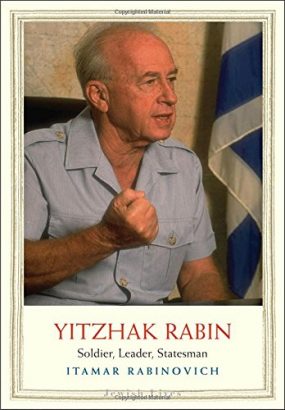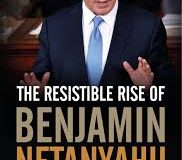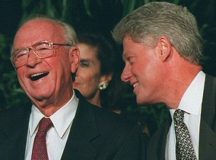I must warn the reader at the start of this review of a couple of personal points that might be considered by some to distort my viewpoint on this book. I regard Yitzhak Rabin as the most important prime minister in Israel’s short history (or to be precise equal number one with David Ben-Gurion, Israel’s first and longest serving leader). This might surprise some readers who would put figures such as Menachem Begin, or even Benjamin Netanyahu (Israel’s second longest serving leader) above Rabin in the ranking order.
In light of this personal perception, it’s worth pointing out that I have always wanted to write my own biography of Rabin. My final admission is that I have always been a little suspicious of diplomatic figures such as Itamar Rabinovich whose careers have straddled both active diplomacy and academia. To me, there is a sense that such figures retain a strong interest in developing particular academic narratives that justify their work and actions as diplomats.
Taking all of the above together, I started reading the book with a degree of scepticism and suspicion at how a book of under 250 pages of text could possibly do justice to the life of such an important Israeli leader. I am pleased to report that all my concerns were misplaced. Rabinovich’s biography of Rabin is masterly and the perfect example of when less is more. It is likely to remain the definitive book on Rabin’s life and career for some years to come.
As the title of the book indicates, Rabinovich divides Rabin’s career into three stages: solider, leader and statesman. The distinction between the last two stages is important as Rabin’s first period as prime minister (1974-77) is widely seen as being very different to his second time as leader (1992-1995). Given the structure of the book and the number of pages that the author (correctly) devotes to Rabin’s time as Israeli Ambassador to the US, he could have added the additional subtitle of ‘diplomat’ to the title of the book.
The first part of the book offers the traditional narrative of Rabin as the soldier and the officer climbing up the greasy pole of the IDF to reach the position of Chief of Staff. There remains much debate in Israel as to just how successful Rabin was in this position.
Here Rabinovich highlights two important points that are often used against Rabin: his apparent collapse on the eve of the Six-Day War in 1967 and his poor relationship with Abba Eban, Israel’s minister of foreign affairs. Rabinovich largely dismisses the importance of Rabin’s collapse in 1967, arguing that it was only brought into the public domain much later by his political opponents in order to try to damage his character with the Israeli electorate.
Rabin’s poor relationship with Eban was a more dangerous threat as it continued into the early part of Rabin’s post-IDF career. Both men had disagreed with one another over key parts of Israel’s build-up to the Six-Day War and Eban had initially opposed Rabin’s post-war appointment as ambassador to Washington. They clashed again over the War of Attrition (1967-70) and in particular Rabin’s calls for an escalation of the war to try damage President Gamal Abdel Nasser of Egypt. As Rabinovich outlines in detail:
The acrimonious debate between the foreign minister [Eban] and the Washington ambassador [Rabin] was yet another turn in a relationship that was going from bad to worse. As we have seen, Rabin and Eban had a sharp disagreement in May 1967 when Eban argued in the Israeli cabinet that the United States did not want to see Israel go to war over the closure of the Tiran Straights. Later when Rabin asked Eshkol to send him to Washington, Eban objected.
Israeli politics is full of stories of such rivalries and problematic personal relationships, but Eban remained a real threat to Rabin’s blossoming career as a diplomat.
In retrospect, Rabin’s time in Washington was important in helping him develop contacts and lasting relationships with key Americans such as Henry Kissinger. It also turned out to be important in distancing Rabin in the public’s mind from the leadership of the Labor Party’s failings for the October 1973 War.
Rabinovich expertly outlines Rabin’s rise to power in 1974, as well highlighting the plusses and minuses of his first government from 1974 to 1977. The resignation of Rabin in 1977 over a scandal involving his wife (Leah Rabin kept an active bank account in the US in violation of Israel’s currency laws) is covered in detail. The dispute between Rabin’s Labor Party and the National Religious Party, which led to the collapse of the coalition government is also explained in depth, as is its long-term consequences for Israeli politics.
After 29 years in opposition, Menachem Begin and the Likud won the resulting election in 1977. Since then, with the exception of two periods (1992-1996 and 18 months from 1999 to the start of 2001) the centre-right in Israel (Likud or Kadima) has enjoyed at least a share of power in Israel. In other words, while few saw it that way back in 1977, the centre-right took over from the centre-left as the natural party of government in Israel.
In 1977, Rabin’s political prospects looked bleak and his chances of getting a second shot at being prime minister were very remote. While his intra-party rival, Eban had long departed the political scene, Rabin’s career became linked to another political opponent from within the Labor Party, Shimon Peres.
Commentators have trawled over almost every aspect of the Rabin-Peres relationship (or running feud, as several refer to it). To his credit, Rabinovich, who clearly leans to the side of Rabin, tries his best to be even-handed on it. In truth, neither Rabin nor Peres covered themselves in much glory with the rivalry coming to dominate many aspects of the centre-left camp in Israel from 1974 until Rabin’s assassination in 1995.
In 1977, Peres succeeded Rabin as leader of the Labor Party and it would take Rabin 15 long years to wrestle back the position from his successor. This despite Peres’s failure to win the 1977 election, or to secure an outright victory in the 1981, 1984 and 1988 elections. Indeed, paradoxically after each electoral failure, Peres was somehow actually able to tighten his control over the Labor Party organs at the expense of Rabin.
In one of the most telling and emotive passages in the book, Rabinovich summarises Rabin’s position in 1977 and his route back to power:
Failed leaders are rarely given a second chance. Rabin was to be an exception. By responding to adversity with tenacity, taking full advantage of his skills, and acquiring the political toolbox he had so glaringly lacked during his term as prime minister, Rabin would first re-establish a leadership position for himself in the Labour Party and then go on to build a stronger persona in the Israeli public mind as ‘Mr Security.’ What Rabin lacked in charisma he compensated for with his authority, directness and integrity. A six-year tenure as a popular, authoritative minister of defence would be the perfect platform for regaining the leadership of the Labor Party and the premiership.
As Rabinovich recounts, Rabin’s route back to power was not without self-inflicted wounds. Rabin’s initial support for Ariel Sharon’s Lebanon adventure in 1982 was a case in point. Rabin and the Labor Party found itself out of power for the first time during a major war and their responses to developments were often muddled and hampered by the lack of reliable information from the Likud-led government and from the Ministry of Defence.
Rabin’s second misstep was his handling of the first Palestinian intifada, which broke out in December 1987. Rabin was all too slow to understand the political significance of developments, instead viewing it as simply as another round of violence in the Occupied Territories.
His attempted forceful suppression of the intifada was quite simply wrong on several different levels. Eventually, he came to understand its importance and moved towards trying to start a dialogue with the Palestinians. One of the strangest aspects of this dialogue was Rabin’s secret meetings with the leaders of newly formed Hamas.
Following the failure of the ‘Dirty (or Smelly) Exercise’ in 1990, in which Peres successfully brought down the national unity government but subsequently failed to set up a government led by the Labor Party, Peres’s days as leader were numbered. For once, Rabin was patient and with the help of two spoiler candidates defeated Peres to become leader of the Labor Party in 1992.
Rabinovich’s judgement on the 1992 Israeli election is spot on. Despite Rabin and Labor emerging as the largest party (44 seats to the Likud’s 32) the election result at coalition block level was much closer. Indeed, Rabin had to rely upon the Israeli Arab parties to help give him a blocking majority over the members of the Likud coalition block.
As the author reminds us, this development was vital as it allowed the ultra-orthodox party, Shas, to effectively cross the floor and join a Rabin-led coalition. Without the participation of Shas, Rabin would have in all probability opted for yet another national unity government and the historic developments that took place from 1992 to 1995 would not have happened.
Arguably the most interesting and revealing part of the book comes in its final sections, particularly in aspects of the peace process from 1992 to 1995 that came within the remit of the author during his time as Israel’s Ambassador to the US. Although Rabinovich does not offer anything that is not already known by experts, he does add some meat to the bones about the various offers Rabin made to the Syrians. Some readers might find it shocking that Rabin, who stated so clearly during the 1992 election campaign that Israel would not come down from the Golan Heights, so readily and quickly offered to trade them for peace with Syria, on the condition that Israel’s security interests were protected.
Rabinovich carefully navigates the narrative of the book between the various tracks of the peace process that Rabin instigated: Syria, the Palestinians and the Jordanians. In some respects, Rabin remained a very typical Israeli prime minister. He very much preferred bi-lateral over multi-lateral negotiations with the Arabs and believed that he should only negotiate on one track of the peace process at a time. The political costs and risks of making painful concessions on more than a single track at any given time were simply too great for the cautious Rabin.
Once again, the rivalry between Rabin and Peres raised its ugly head during the peacemaking years of the Rabin-led government. It was in the negotiations with King Hussein of Jordan that the animosity really came to a head. As Rabinovich recounts events:
But Peres, who conducted himself impressively during his meeting with the king, couldn’t resist the urge to assume credit for the unfolding process with Jordan. Peres was on a roll after the Oslo Accords. He was the architect of the agreement, and he asked for and received a lot of credit for the breakthrough. The balance between him and Rabin shifted in his favour, and he was pushing ahead. Peres made no secret of his supposed secret meeting with the king, and in short order the media reported it. The king was incensed and told Rabin that if he wanted to move forward with Jordan, he would have to keep Peres out of the picture. Rabin was quite happy to do so. Here was an opportunity to retake the initiative in leading the peace process.
Things can’t have been easy for Rabin at the time with his long-term political rival vying for credit for the peace process, increased violence in Israel with suicide attacks from Hamas and Islamic Jihad, and the Americans applying pressure to make additional political concessions to the Arabs. No wonder that the veteran American diplomat, Henry Kissinger, characterised Rabin as being politically lonely.
Rabinovich argues that Rabin, while still cautious and concerned with Israeli security needs, was transformed from a leader into a statesman. This is very much the theme of the final part of the book as Israel became more politically polarised and where radical elements opposed to the peace process gained additional traction and started making plans to end the Rabin/Peres drive for peace, whatever it took.
When I wrote my book on Benjamin Netanyahu, Rabin’s political rival at the time, I was struck by what I saw as an abandonment of the centre-ground by the young Likud leader. Rabin, as Rabinovich points out, was never completely as ease with the leftist element of the peace camp in Israel and emphasises his more pragmatic centrist approach to peacemaking far more than for example, Shimon Peres.
The final part of the book looks at the lead up to, and the events surrounding the assassination of Rabin. Here the author takes off the gloves and we can feel his anger at the intelligence and security mistakes that characterised the road to the murder. The author poses the key question as to how Rabin’s killer was able to act, but we still do not fully understand the answer to it. He writes:
How could a man like Yigal Amir, known to the GSS [General Security Services – the Shin Bet], get close enough to the prime minister of Israel to assassinate him? Israel is a country deeply familiar with terrorism and violence and well versed in security measures. Amir’s success can be explained by the impact of a mind-set, by a series of accidents and near misses, and by sheer incompetence.
The assassination was one of the most traumatic moments in Israeli democracy. The political judgement of Peres, Rabin’s successor as Prime Minister, is correctly questioned by Rabinovich. Many felt that Peres was wrong not to call a snap election after the assassination.
Such an election would have in all likelihood resulted in a landslide victory for Peres and the Labor Party. It would have also probably ended the political career of Benjamin Netanyahu. Peres, however, as the author points out ‘wanted to be elected on his own terms rather than as Rabin’s avenger’. It turned out to be a tragic mistake for the centre-left in Israel and for the prospects of the Oslo Accords.
As a scholar of the Arab-Israeli conflict the most interesting part of the book was the brief epilogue during which Rabinovich talks of the ‘clash of narratives over Rabin’s legacy, heritage and memory’. The ‘what if’ counter-narrative to Rabin’s death is something that I continue to think about and included in my own book on Netanyahu.
It was by no means certain that Rabin would have won the 1996 election. Israel’s first direct election for prime minister would have been very close. At the time of Rabin’s death, he was trailing Netanyahu in the opinion polls. And had he won, it was also by no means certain that he would have wanted to or been able to conclude a final-status deal with Yasser Arafat.
Rabinovich doesn’t really try to offer definitive answers to the above counter-narratives. It is, however, a fitting way to conclude a wonderfully incisive and informative book on one of modern Middle East’s most important military and political leaders.






































Comments are closed.